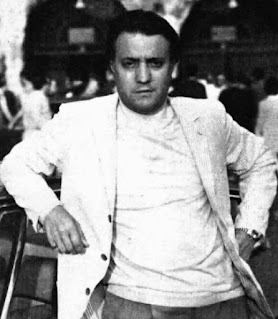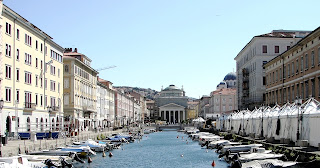Singer highly respected for interpretation of Verdi roles
 |
| Piero Cappuccilli as Ernani in a performance of Verdi's Don Carlo |
Although not exclusively, Cappuccilli’s focus was predominantly the work of Italian composers, in particular Giuseppe Verdi, in whose operas he sang 17 major roles.
He sang at many of the world’s great opera houses, travelling to South America and the United States, where he made his debut at the Metropolitan Opera in New York as Giorgio Germont in Verdi’s La traviata in 1960 and had a particular association with the Lyric Opera in Chicago, where he made his first appearance in 1969 as Sir Richard Forth in Bellini's I puritani and returned many times before his farewell performances there in 1986.
Nonetheless, he spent most of his time in Europe. He made his debut at Milan’s Teatro alla Scala in 1964 as Enrico in Donizetti’s Lucia di Lammermoor; at the Royal Opera House in Covent Garden as Germont in 1967; and at the Opéra de Paris in 1978, singing Amonasro in Verdi’s Aida. He also appeared at the Vienna State Opera and the Salzburg Festival and worked with Europe’s finest conductors, including Herbert von Karajan, Gianandrea Gavazzeni, Claudio Abbado, and Carlos Kleiber.
 |
| Cappuccilli was initially reluctant to pursue the idea of a career in opera |
Cappuccilli first encountered opera as a 10-year-old boy, during a family holiday, when he was recruited for the children's chorus of a production of Bizet’s Carmen in Naples. He thought nothing at that stage of a career in music, focussing his ambitions on becoming an architect.
As a young adult, friends noted the quality of his voice whenever he sang and in 1949 encouraged him to audition at the opera house in Trieste, the Teatro Giuseppe Verdi. Luciano Donaggio, an opera teacher, heard him and thought he had enough potential to offer him free lessons.
Even then, Cappuccilli was not convinced it was worth his time and gave up for a while. But Donaggio ultimately persuaded him he was good enough to contemplate a career in opera and he joined the company at the Teatro Giuseppe Verdi in 1951, taking a succession of small parts.
 |
| Many of Cappuccilli's performances have been preserved in a large discography |
In the years that followed, Cappuccilli not only excelled for the rich quality of his voice, outstanding breath control and immaculate phrasing but for the sensitive interpretation of the characters he portrayed. Critics spoke of him in the same breath as Tito Gobbi and Ettore Bastianini among the great Italian baritones.
He seldom disappointed in any role but his performances in Aida and Forza del Destino at La Scala in the 1960s attracted particularly enthusiastic reviews, while London critics were wowed by his interpretation of the title role in Verdi's Simon Boccanegra when the La Scala company guested at Covent Garden in 1976.
Happily, many great performances were preserved in an extensive discography that includes performances alongside Maria Callas, Katia Ricciarelli, Placido Domingo and Mirella Freni under the baton of Von Karajan and Abbado among others.
Cappuccilli spent his final years back in Trieste, where he died in 2005, aged 78. He left a wife, Graziella, three children and two grandchildren. He is buried at the Cimitero di Sant’Anna.
Travel tip:A view of the Canale Grande in Trieste, the
maritime capital of Friuli-Venezia Giulia
The seaport of Trieste, capital of the Friuli-Venezia Giulia region, officially became part of the Italian Republic in 1954. Trieste had been disputed territory for thousands of years and after it was granted to Italy in 1920, thousands of the resident Slovenians left. The final border with Yugoslavia was settled in 1975 with the Treaty of Osimo. The area today is one of the most prosperous in Italy and Trieste is a lively, cosmopolitan city and a major centre for trade and ship building. The city has a coffee house culture that dates back to the Hapsburg era. Caffè Tommaseo, in Piazza Nicolò Tommaseo, near the grand open space of the Piazza Unità d’Italia, is the oldest in the city, dating back to 1830.
Travel tip:Piazza San Babila is the home of
Milan's Teatro Nuovo today
The Teatro Nuovo theatre in Milan, located on the Piazza San Babila in the lower level of the Palazzo del Toro, was designed by architect Emilio Lancia and was the project of the impresario Remigio Paone. It was inaugurated in December 1938 with a performance of Eduardo De Filippo's comedy Ditegli sempre di sì. Piazza San Babila is characterized by the presence of a fountain built in 1997 by the architect Luigi Caccia Dominioni in conjunction with the Ente Fiera Milano.
Also on this day:
1383: The birth of military leader Niccolò III d’Este
1877: The birth of Enrico De Nicola, the first president of Italy
1921: The birth of football stickers pioneer Giuseppe Panini
1974: The birth of footballer Alessandro Del Piero
(Image of Canale Grande by Severin Herrmann from Pixabay)


No comments:
Post a Comment